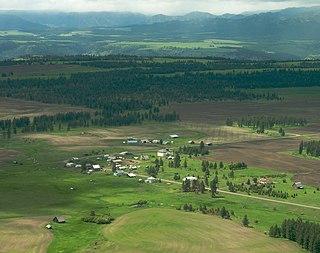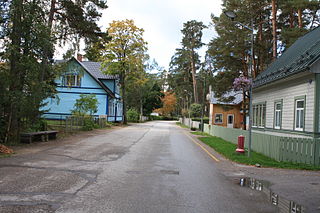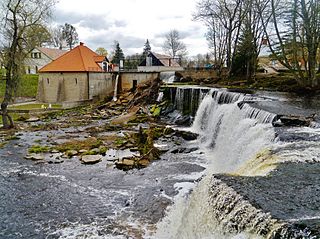
A borough is an administrative division in various English-speaking countries. In principle, the term borough designates a self-governing walled town, although in practice, official use of the term varies widely.

A town is a type of a human settlement. Towns are generally larger than villages and smaller than cities, though the criteria to distinguish between them vary considerably in different parts of the world.

Narva is a municipality and city in Estonia. It is located in the Ida-Viru County, at the eastern extreme point of Estonia, on the west bank of the Narva river which forms the Estonia–Russia international border. With 53,626 inhabitants Narva is Estonia's third largest city after capital Tallinn and Tartu.

A municipality is the smallest administrative subdivision of Estonia. Each municipality is a unit of self-government with its representative and executive bodies. The municipalities in Estonia cover the entire territory of the country.

Kohtla-Järve is a city and municipality in northeastern Estonia, founded in 1924 and incorporated as a town in 1946. The city is highly industrial, and is both a processor of oil shales and is a large producer of various petrochemical products. During the 1944–1991 Soviet occupation, large numbers of immigrant workers from Russia and other parts of the former USSR were brought in to populate the rapidly growing city. The population in the Kohtla-Järve area which had been, as of 1934 census, over 90% ethnic Estonian, became overwhelmingly non-Estonian in the second half of the 20th century. According to more recent data 21% of the city's population are ethnic Estonians; most of the rest are Russians. Kohtla-Järve is the fifth-largest city in Estonia in terms of population.

Otepää is a town in Valga County, southern Estonia. It is the administrative centre of Otepää Parish. Otepää is a popular skiing resort, popularly known as the "winter capital" of Estonia. During the 2005–2006 season it became the site for FIS Cross-Country World Cup events. Otepää is located the highest of the Estonian cities, up to 152 meters above sea level.

In geography, statistics and archaeology, a settlement, locality or populated place is a community of people living in a particular place. The complexity of a settlement can range from a minuscule number of dwellings grouped together to the largest of cities with surrounding urbanized areas. Settlements may include hamlets, villages, towns and cities. A settlement may have known historical properties such as the date or era in which it was first settled, or first settled by particular people. The process of settlement involves human migration.
Estonia is a unitary country with a single-tier local government system. Local affairs are managed autonomously by local governments.

Tamsalu Parish was a rural municipality of Estonia, in Lääne-Viru County. It had a population of 3,726 and an area of 214.61 km2.

Audru is a small borough in Pärnu municipality, Pärnu County, southwestern Estonia. Before the administrative reform in 2017, Audru was the administrative centre of Audru Parish. At the 2011 Census, the settlement's population was 1,492.

Võsu is a small borough in Lääne-Viru County, in Haljala Parish, in Estonia. It was the administrative centre of Vihula Parish. As of the 2011 census, the settlement's population was 334.
Aabra is an uninhabited village in Rõuge Parish, Võru County, in southeastern Estonia. It is located on the territory of Haanja Nature Park, about 8 km (5 mi) southeast of Rõuge, the administrative centre of the municipality, and about 18 km (11 mi) south of the nearest town Võru.
Local government in Pennsylvania is government below the state level in Pennsylvania. There are six types of local governments listed in the Pennsylvania Constitution: county, township, borough, town, city, and school district. All of Pennsylvania is included in one of the state's 67 counties, which are in total subdivided into 2,560 municipalities. There are currently no independent cities or unincorporated territories within Pennsylvania. There is only one incorporated town in Pennsylvania, Bloomsburg.
Ämmuste is a village in Viljandi Parish, Viljandi County, Estonia. Until the 2017 administrative reform of Estonian municipalities the village was located in Tarvastu Parish. It is located 6.4 km south of the small borough of Mustla and 24 km southwest of the town of Viljandi near the border of Valga County. As of 2011, Ämmuste had a population of 15 residents, a decrease from 22 in the 2000 census. These figures, however, do not reflect the population number when students and faculty of Ämmuste School are factored in.
Kannuküla is a village in Viljandi Parish, Viljandi County, Estonia. Until the 2017 administrative reform of Estonian municipalities the village was located in Tarvastu Parish. Kannuküla is located 28 km (17) southeast of the town of Viljandi, 12 km southwest of the small borough of Mustla, near the border of Viljandi County and Valga County. Neighboring villages include Kärstna, Anikatsi and Ämmuste. The population of Kannuküla as of 2011 was 42, a decrease from 61 in the 2000 census.
Kuressaare is a village in Viljandi Parish, Viljandi County, Estonia. Until the 2017 administrative reform of Estonian municipalities the village was located in Tarvastu Parish. Kuressaare is located 23 km (14) southeast of the town of Viljandi, 3.8 km southwest of the small borough of Mustla. Neighboring villages include Pikru, Ämmuste and Jakobimõisa. Kuressaare had a population of 67 as of 2011, a decrease from 85 in the 2000 census.
Kalbuse is a village in Viljandi Parish, Viljandi County, Estonia. Until the 2017 administrative reform of Estonian municipalities the village was located in Tarvastu Parish. Kalbus is located 19 km southeast of the town of Viljandi, 5.5 km northwest of the small borough of Mustla, near the western shore of Lake Võrtsjärv. Neighboring villages include Vanausse, Mõnnaste, Koidu and Väluste. As of 2011, Kalbuse had a population of 18, a steep decline from 59 in the 2000 census.

A rural municipality is a classification of municipality, a type of local government, found in several countries.

Lääne-Harju Parish is a rural municipality in northern Estonia. It is a part of Harju County. The municipality has a population of 12,865 and covers an area of 645.71 km2. The population density is 19.9238/km2 (51.6024/sq mi).












